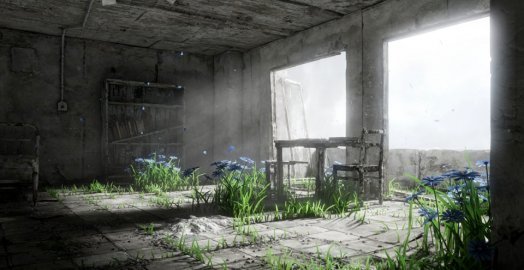Review for Homesick

The opening moments of Homesick induced a vague flashback to my college years, which is to say I woke up in a greyish, rather dumpy room with a busted ceiling fan, a few indecipherable papers scattered about and ostensibly no memory of preceding events. I sometimes wonder if it’s some inherent unquantifiable facet of human nature or just the way my brain is wired from a lifetime of adventure games that I’m rather nonplussed by this and my first instinct is to fling open cabinets and cupboards, flip every switch I can find and pick up, pull, prod or screw with anything that’s generally not nailed down (and if it is nailed down, I’ll generally look for something to pry it up with). Given that I’m predisposed to this sort of behavior just as often in real life, it could probably go either way.
And so, in those early minutes of the game, I eventually found a bucket I could pick up, filled it with water from a bathtub and poured it on some wilted plants that were growing from the floor of the room I woke up in. (This might be something of a spoiler, but it was in the gameplay trailer, so I consider it fair game). Why did I execute this particular sequence of events? For the only reason that you ultimately do anything in this type of game…because I could.
It’s an interesting thing that with the advent of the first-person adventure gaming perspective, popularized by Myst and its ilk, the deliberate absence of an explicit narrative became an acceptable and often compelling (depending on who you ask) storytelling device, and a significant part of gameplay became simply wandering around and effing with everything until you found something tangible to do. It doesn’t seem like you could get away with this sort of thing in a traditional third-person game, perhaps because we’re less likely to tolerate a visible avatar with no apparent agenda, which is a bit like having an uninvited stranger sitting on your living room sofa staring at you for no apparent reason.
I suppose that looking through the eyes of our avatar and observing the world “directly” gives us a sense of agency so that just walking around and looking at stuff feels like a tangible activity, rather than just clicking around on the screen (even if it’s essentially the same thing). In particular, once we could transplant this experience into a fancy real-time 3D engine, it became a lot easier to enhance this sense of agency so that the balance of gameplay could effectively shift even more towards the idea of exploration and discovery – which is to say, walking around and looking at stuff. And therefore, the only apparent objective of any of these games is to find a way to move forward, notwithstanding the why (but assuming that the why will eventually reveal itself through the act of exploration).
To that end, I poured a bucket of water on some flowers because it was the only tangible thing I could do that promised to unlock the way forward, even if I had no rationale for doing such. But then, Homesick is essentially a game about moving forward, and although it’s entirely possible to finish the game without bothering with any context or backstory, you can probably take an educated guess at the motivation from the title.
Wandering around the initial room, I instinctively made for the open doors leading to a balcony and what looked like a welcome respite from the dingy building I was in, but as I moved closer, the sunlight became blinding to such a degree that it physically stopped my approach, and effectively defined one of my obstacles going forward. It also effectively established the overarching mood; the light offered potential comfort and escape from my rather squalid surroundings, but I was categorically and repeatedly denied that small comfort.
As I continued to explore, an atmosphere of general gloom hung over the decaying environment. This world exists in a rather bleak, monochromatic palette of greys and browns, punctuated by the occasional spare splash of actual color to tease you, much like the blinding sunlight, of a less forlorn world that probably exists outside the grey walls you’re trapped within.
As depressing as it sounds, which I’m assuming was quite intentional, it’s a testament to the fine graphic design that it feels appropriately depressing. The contrasting graphical style is reminiscent of that used in The Lost Crown, albeit (thankfully) without the godawful interminable voice acting. As effective as it is in setting the mood, however, the scenery does gets a bit same-y after a while, since the building you spend the game exploring is essentially a collection of rooms and corridors with the same variety of rotting furniture and scattered rubbish, but in slightly different configurations. If the game were much longer (and I’ll come back to that in a bit), it might to start to lose its punch, but as it is, it’s quite effective.
Aside from the very occasional creak of a door or some such, the only sound to be heard is a rather nice piano and cello arrangement that I would describe as soothing, melancholy and haunting in equal measures. Homesick is a quiet game altogether; the environmental noises are spare, there are no voices to be heard, and the background score only serves to augment a feeling of solitude.
But although this feels like an aloof exploration game, mechanically it plays mostly like a straightforward adventure. Puzzles are a combination of inventory (e.g., the bucket of water) and environmental (flipping switches and such). Anyone who’s seen the different trailer for the game has probably made note of a section in which you’re moving down a hallway carrying an axe while strands of dark ooze rain down on you in what looks vaguely like a scene from a Silent Hill game. The first time this happened, I was preparing myself to start splitting zombie heads open, but it’s not that kind of game.
So just to be clear, there is no bashing of heads, no survival horror element and no boogeymen chasing you through the dark hallway. When night comes, the darkness plays the same role as the sunlight during the day, which is an impasse. The flip side of that is that places that were impassible because of the daylight are traversable at night, so the interplay between dark and light is ultimately part of the gameplay mechanic, and while it’s possible to be overwhelmed by the creeping darkness, it merely sends you back to your bed to restart the night segment. Fortunately, the night segments are fairly brief and straightforward, so there’s little chance of getting stuck in these.
Likewise, the majority of the puzzles overall are pretty straightforward, bordering on fairly simple. There is a single puzzle late in the game which I got tripped up on for a significant amount of time. I’m somewhat tempted to cry foul on this one, however, because it requires a leap of logic regarding the interface. The controls are the standard real-time 3D song-and-dance, which work as expected, with the exception of the one puzzle which I eventually sorted out after resorting to stabbing at the keyboard in frustration. To be fair, it’s possible the game was innocently asking for a bit of lateral thinking; I have no issue with that so long as the game tells me that sort of thing is in play, but if it explicitly says this is how the controls work, I’m wont to call shenanigans, because by that point, my left brain is telling my right brain to quiet down and toe the line.
But even with this setback, which easily cost me half an hour or so, I found myself staring at the credits about three hours in. The story, such as it is, is primarily related through the various books and journals and notes scattered around the environment. At the beginning of the game, these consist of a jumble of indecipherable symbols, but in accordance with the by-laws of the Adventure Gamers Local 114, anyone playing such a game is contractually required to decipher any unknown symbols at some point. Once you do, this in turn deciphers all of the texts you’ve come across, so it’s possible to go back and read through everything you’ve missed. However, this occurs relatively late in the game, and aside from a couple of short notes you’ll need to solve a few puzzles (which are placed in very obvious locations), it takes a deliberate effort to backtrack and re-read everything lying around. I did, because I’m rather obsessive-compulsive about that sort of thing, but it’s entirely optional and quite likely that someone caught up in puzzle-solving will keep plowing ahead and complete the game without having touched any of the written material. In terms of storytelling, this isn’t the greatest tragedy since I would argue that the atmosphere and setting are enough to convey the theme (especially considering that the “story” is pretty oblique), but moreover, it’s entirely possible that someone could easily breeze through the game in under two hours.
It’s not necessarily a knock against a game that it’s short. Length is certainly not the best arbiter of quality (or so I often tell myself). But more to the point, a game can be quite short and still feel “complete” (see To the Moon, Gone Home). It’s admittedly a bit of an intangible measure of quality, but when I finish a game, I can say “well, that was a hell of a thing” or “is that it, then?”. Unfortunately, when the credits finished, Homesick ultimately fell into the latter category.
For all it provides in atmosphere, Homesick still feels incomplete. Depending on whether you spend any time going back to read everything, the story itself is either somewhat threadbare or largely nonexistent. So as a narrative experience, it’s not entirely satisfying, and likewise, to the extent that the puzzles tend to be a bit rote, it’s not especially satisfying as a traditional adventure game. The regrettable thing is that it feels as if it could be both; there was a lot of opportunity to add more depth to both the puzzles and the narrative, but for now, it seems more like a glorified demo for something greater. Much like the promise of the sunny, cheerful world that lies just beyond your grasp throughout the game, it feels like the promise of a far better game lies just beyond Homesick’s grasp.





























